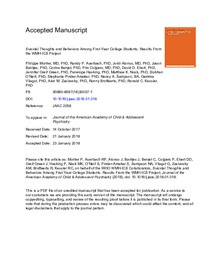Por favor, use este identificador para citar o enlazar este ítem:
https://hdl.handle.net/11000/34560Registro completo de metadatos
| Campo DC | Valor | Lengua/Idioma |
|---|---|---|
| dc.contributor.author | MD, Philippe Mortier | - |
| dc.contributor.author | Auerbach, Randy P. | - |
| dc.contributor.author | MD, Jordi Alonso | - |
| dc.contributor.author | Bantjes, Jason | - |
| dc.contributor.author | Benjet, Corina | - |
| dc.contributor.other | Departamentos de la UMH::Psicología de la Salud | es_ES |
| dc.date.accessioned | 2025-01-15T20:08:23Z | - |
| dc.date.available | 2025-01-15T20:08:23Z | - |
| dc.date.created | 2018-01 | - |
| dc.identifier.citation | Journal of the American Academy of Child & Adolescent Psychiatry, Volume 57, Issue 4, April 2018, Pages 263-273 | es_ES |
| dc.identifier.issn | 1527-5418 | - |
| dc.identifier.issn | 0890-8567 | - |
| dc.identifier.uri | https://hdl.handle.net/11000/34560 | - |
| dc.description.abstract | ollege entrance may be a strategically well-placed “point of capture” for detecting late adolescents with suicidal thoughts and behaviors (STB). However, a clear epidemiological picture of STB among incoming college students is lacking. We present the first cross-national data on prevalence as well as socio-demographic and college-related correlates for STB among first-year college students. Method Web-based self-report surveys were obtained from 13,984 first-year students (response rate 45.5%) across 19 colleges in 8 countries (Australia, Belgium, Germany, Mexico, Northern Ireland, South Africa, Spain, and the United States). Results Lifetime prevalence of suicidal ideation, plans, and attempts was 32.7%, 17.5%, and 4.3%, respectively. The 12-month prevalence was 17.2%, 8.8%, and 1.0%, respectively. About three-fourths of STB cases had onset before the age of 16 years (Q3 = 15.8), with persistence figures in the range of 41% to 53%. About one-half (53.4%) of lifetime ideators transitioned to a suicide plan; 22.1% of lifetime planners transitioned to an attempt. Attempts among lifetime ideators without plan were less frequent (3.1%). Significant correlates of lifetime STB were cross-nationally consistent and generally modest in effect size (median adjusted odds ratio [aOR] = 1.7). Nonheterosexual orientation (aOR range 3.3−7.9) and heterosexual orientation with some same-sex attraction (aOR range 1.9−2.3) were the strongest correlates of STB, and of transitioning from ideation to plans and/or attempts (aOR range 1.6−6.1). Conclusion The distribution of STB in first-year students is widespread, and relatively independent of socio-demographic risk profile. Multivariate risk algorithms based on a high number of risk factors are indicated to efficiently link high-risk status with effective preventive interventions. | es_ES |
| dc.format | application/pdf | es_ES |
| dc.format.extent | 39 | es_ES |
| dc.language.iso | eng | es_ES |
| dc.publisher | Elsevier | es_ES |
| dc.rights | info:eu-repo/semantics/openAccess | es_ES |
| dc.rights | Attribution-NonCommercial-NoDerivatives 4.0 Internacional | * |
| dc.rights.uri | http://creativecommons.org/licenses/by-nc-nd/4.0/ | * |
| dc.subject.other | CDU::5 - Ciencias puras y naturales::50 - Generalidades sobre las ciencias puras | es_ES |
| dc.title | Suicidal Thoughts and Behaviors Among First-Year College Students: Results From the WMH-ICS Project | es_ES |
| dc.type | info:eu-repo/semantics/article | es_ES |
| dc.relation.publisherversion | https://doi.org/10.1016/j.jaac.2018.01.018 | es_ES |

Ver/Abrir:
Mortier et al., 2018 (1).pdf
478,9 kB
Adobe PDF
Compartir:
 La licencia se describe como: Atribución-NonComercial-NoDerivada 4.0 Internacional.
La licencia se describe como: Atribución-NonComercial-NoDerivada 4.0 Internacional.
.png)